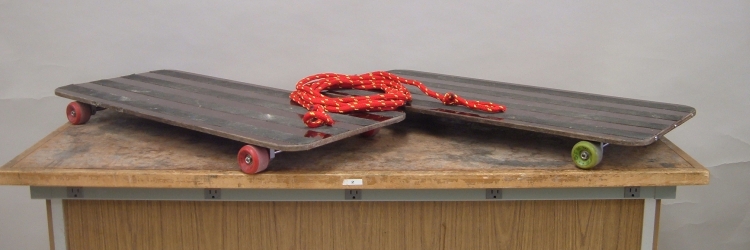

With the skateboards set end to end, have a student stand on each one, each student facing the other. Have one student push against the other, and they both move apart. Now have each student grab one end of the rope. Have one student pull his end of the rope, and they both move toward each other. Points to note are that whichever student applies a force, in whichever direction (push or pull), the other student must simultaneously apply an equal and opposite force (Newton’s Third Law of Motion), that students’ speeds after the push or pull are in inverse proportion to their masses (they have equal and opposite momenta), and that the center of mass of the system comprising the skateboards and the students (and the rope) never moves, unless someone provides an external force by pushing or pulling on one of the students (or skateboards).
This demonstration provides an illustration of Newton’s third law of motion, which states (as quoted in Resnick, Robert and Halliday, David. Physics, Part 1, Third Edition (New York: John Wiley and Sons, 1977), p. 79) To every action there is always opposed an equal reaction; or, the mutual actions of two bodies upon each other are always equal, and directed to contrary parts. When you place the skateboards near each other, end to end, and have a student stand on each skateboard, when one student pushes against the other, both students move off in opposite directions. Whatever force the first student applies to the second student, the second student must provide an equal force in the opposite direction, and both students move apart. If each student is holding the rope, when the first student pulls the rope, as long as the second student does not let go of the rope, the second student must again provide an equal force in the opposite direction, and both students move toward each other.
According to Newton’s Second Law, if one student is larger than the other (they have different masses), then the smaller student is accelerated more greatly than the larger one. Since momentum must be conserved, because the initial momentum of the system comprising the skateboards and students (and rope) was initially zero (unless someone applied an external force by pushing or pulling on one of the students (or skateboards)), the students must move apart or together with equal and opposite momenta; their speeds are in inverse proportion to their masses.
Also, because the system is initially at rest, unless someone applies an external force, its center of mass must remain in the same place. The students, then, when they push off to separate, and then pull to bring themselves back together, must come back to the same places from which they started.